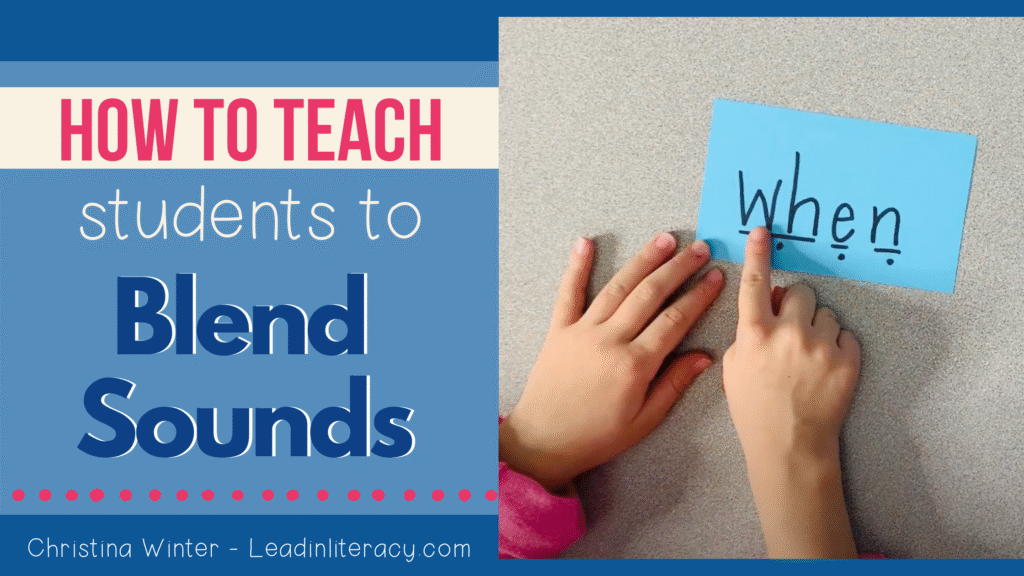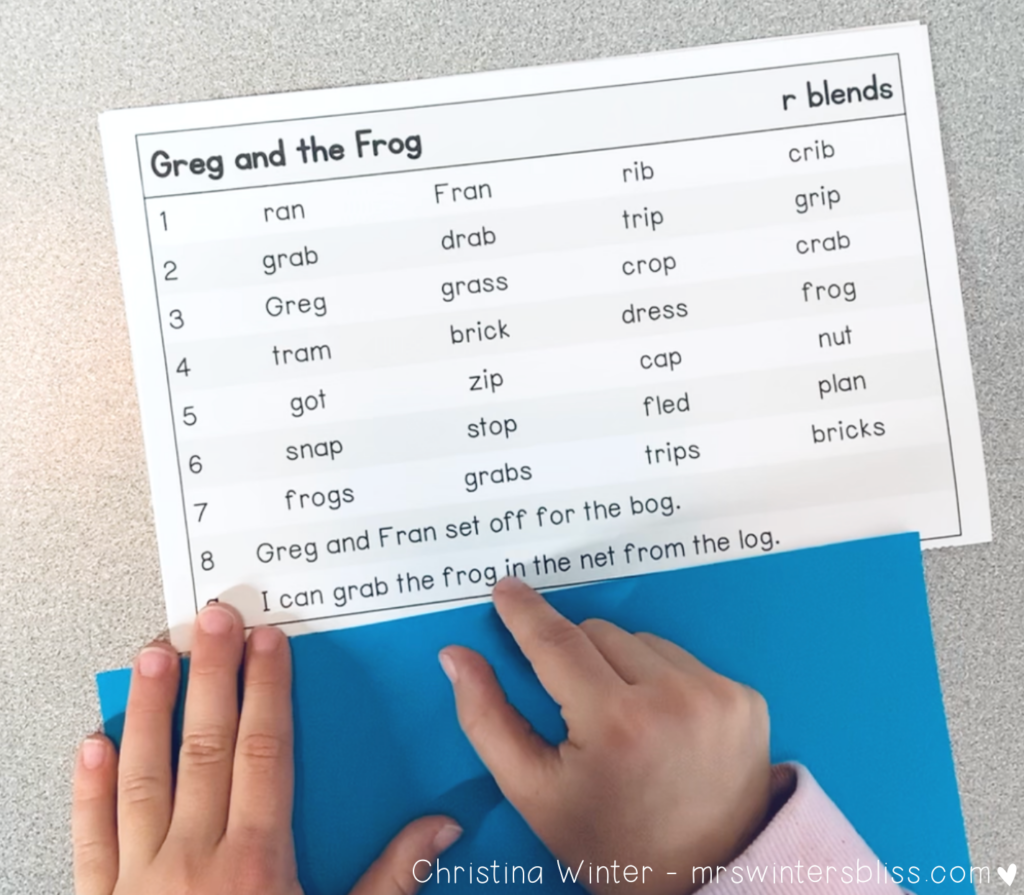In this post, we’ll discuss….
- Why it is important to teach students how to blend sounds
- Common challenges students have with blending
- Blending instructional routines
- What to do if students aren’t able to blend sounds
- Blending activities for students
Have you ever listened to a student slowly say /c/…/a/…/t/ and then confidently say “TAG”? This is a common error. Blending can be one of the trickiest skills to teach and one of the hardest for students to internalize. Yet, it’s also one of the most important. When students learn to blend effectively, they take their understanding of sounds and apply it to print.

Today I’m excited to take a closer look at why blending really matters. I’ll share the common challenges we encounter when teaching blending and leave you with evidence-based routines for teaching this essential skill.
Why Blending Matters
Blending is the process of smoothly combining individual phonemes (sounds) to form a whole word. It’s the step that connects oral language to written language. It’s foundational for developing automatic word recognition.
Research shows that strong blending skills are predictive of later reading fluency and comprehension. When students blend sounds accurately and efficiently, they begin to recognize words more quickly, freeing up mental energy for understanding what they read.
Blending also plays a central role in orthographic mapping. This is the process that allows students to store words permanently in memory. If students cannot blend, they cannot map words for future recognition.

Common Blending Challenges
Even skilled teachers find that blending instruction isn’t always smooth. Some of the most common challenges include:
- Students can segment sounds but can’t put them together.
They may identify /c/, /a/, and /t/ but struggle to merge those sounds into “cat.” - Adding extra vowel sounds (schwas).
This is especially common when pronouncing stop consonants. For example, /buh/ instead of /b/ makes it harder for students to hear the true blend. - Inconsistent routines.
When modeling and instructional routines vary day to day, students lose the predictability they need to internalize the process. - Limited practice opportunities.
Students need frequent, intentional blending practice. It must be woven in throughout the day. - Overemphasis on accuracy before fluency.
Students often need to hear what fluent blending sounds like before they can replicate it themselves.
Recognizing these patterns allows you to adjust your own instruction to ensure students get the support they need to begin blending successfully.
Blending Routines
Different blending routines serve different instructional purposes. Knowing which to use, and when, helps students progress from early, supported practice to fluent, independent reading.
1. Successive (Additive) Blending
Successive blending is a scaffolded approach where students blend one sound at a time as they move through a word. It’s especially effective for beginning readers or those with limited phonological working memory.
Example Routine (for “cat”):
- Point to the first letter and say /c/.
- Add the next letter and blend: /ca/.
- Add the final letter and blend again: /cat/.
This process helps students hold each sound in mind while slowly connecting them. Because it builds confidence through repetition, it’s an ideal starting point for young or struggling readers.
In general, students should not spend more than a few weeks on successive/additive blending. It is recommended that you temporarily bring it back when students start reading words with beginning blends.
2. Whole Word (Final) Blending
Whole word blending (sometimes called final blending) is more efficient and natural. Students run their finger under the letters while saying the sounds continuously, allowing the word to “melt” together.
Example Routine (for “cat”):
- Display the full word.
- Slide your finger under the letters as you say the sounds without pausing: /cccaaat/.
- Compress the sounds more quickly until the full word is heard: /cat/.
This method supports fluency and should become the dominant blending approach once students can manage sound sequences independently. It mirrors the smooth, continuous process of skilled reading and prepares students to transition to texts.
Tips to for Teaching Blending
Blending mastery develops through daily, intentional practice. Here are a few high-impact strategies supported by research:
- Begin with continuous sounds.
Start with sounds that can be held, such as /m/, /s/, and /n/, before introducing stop sounds. - Model blending every day.
Your voice is a powerful tool. Consistent modeling gives students a reliable auditory model to imitate. - Provide many practice opportunities.
Aim for at least 20 words per session for first grade and above, as recommended by Wiley Blevins. - Use visual and kinesthetic cues.
Sliding a finger under the word as sounds are blended helps connect print and sound. - Incorporate oral blending practice.
Quick oral blending warm-ups build automaticity even without letters present. - Monitor progress and adjust.
If blending is slow or inaccurate, return briefly to successive blending for reinforcement.
Quick Troubleshooting Guide for Blending Instruction
If blending isn’t clicking for some students, use this as a quick reference to identify next steps:
| If this happens… | Try this… |
|---|---|
| Students can’t blend sounds | Offer more phonemic awareness practice |
| Students blend but say the wrong word | Revisit individual letter-sound correspondences, go back to successive blending practice |
| Students blend slowly or robotically | Use continuous sounds and repeated modeling |
| Students blend but forget the word | Go back to successive blending |
Blending Activities for Students
If you are looking for ways to give your students more blending practice, you’ll want to take a look at my decodable books and passages resources. Each book and passage in these resources includes blending lines that help prepare students for reading.

.
The words in the list offer blending practice and are used to introduce the new skill for the decodable text you are reading. This video walks you through how you would use the blending lines from this resource.
Read more about a routine for using these blending lines and my decodable books here.
Free Blending Lines
If you are ready to give blending lines a try in your classroom, I am happy to offer you a FREE samples of my FICTION and NON-FICTION decodable books! You can get….
- 5 FREE fiction decodable books and 5 FREE non-fiction decodable books aligned to a research-based systematic phonics scope and sequence.
- Explicit lesson plans for each book. These lesson plans will walk you through how to use the included blending lines.
- Student activities to use before, during, and after reading.
- Audio recordings for each passage to ensure you can easily differentiate based on students’ needs.


I hope the information and resources shared here today will help bring more effective blending instruction and practice to your classroom!
-shop this post-

.
